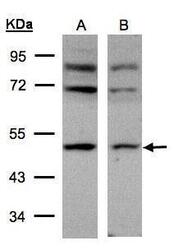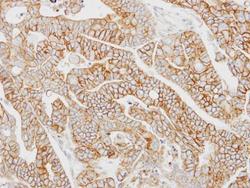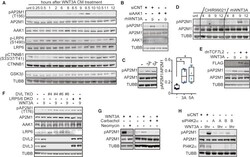Antibody data
- Antibody Data
- Antigen structure
- References [1]
- Comments [0]
- Validations
- Western blot [1]
- Immunohistochemistry [1]
- Other assay [1]
Submit
Validation data
Reference
Comment
Report error
- Product number
- PA5-21360 - Provider product page

- Provider
- Invitrogen Antibodies
- Product name
- AP2M1 Polyclonal Antibody
- Antibody type
- Polyclonal
- Antigen
- Recombinant full-length protein
- Description
- Recommended positive controls: 293T, A431, H1299, HeLaS3, Raji. Predicted reactivity: Mouse (100%), Rat (100%), Xenopus laevis (99%), Dog (100%), Pig (99%), Chicken (97%), Rhesus Monkey (98%), Chimpanzee (100%), Bovine (100%). Store product as a concentrated solution. Centrifuge briefly prior to opening the vial.
- Reactivity
- Human
- Host
- Rabbit
- Isotype
- IgG
- Vial size
- 100 μL
- Concentration
- 0.57 mg/mL
- Storage
- Store at 4°C short term. For long term storage, store at -20°C, avoiding freeze/thaw cycles.
Submitted references WNT Activates the AAK1 Kinase to Promote Clathrin-Mediated Endocytosis of LRP6 and Establish a Negative Feedback Loop.
Agajanian MJ, Walker MP, Axtman AD, Ruela-de-Sousa RR, Serafin DS, Rabinowitz AD, Graham DM, Ryan MB, Tamir T, Nakamichi Y, Gammons MV, Bennett JM, Couñago RM, Drewry DH, Elkins JM, Gileadi C, Gileadi O, Godoi PH, Kapadia N, Müller S, Santiago AS, Sorrell FJ, Wells CI, Fedorov O, Willson TM, Zuercher WJ, Major MB
Cell reports 2019 Jan 2;26(1):79-93.e8
Cell reports 2019 Jan 2;26(1):79-93.e8
No comments: Submit comment
Supportive validation
- Submitted by
- Invitrogen Antibodies (provider)
- Main image

- Experimental details
- Western Blot using AP2M1 Polyclonal Antibody (Product # PA5-21360). Sample (30 µg of whole cell lysate). A: 293T. Lane B: HeLa S3. 10% SDS PAGE. AP2M1 Polyclonal Antibody (Product # PA5-21360) diluted at 1:500.
Supportive validation
- Submitted by
- Invitrogen Antibodies (provider)
- Main image

- Experimental details
- Immunohistochemical analysis of paraffin-embedded N87 xenograft, using AP2M1 (Product # PA5-21360) antibody at 1:100 dilution. Antigen Retrieval: EDTA based buffer, pH 8.0, 15 min.
Supportive validation
- Submitted by
- Invitrogen Antibodies (provider)
- Main image

- Experimental details
- Figure 6 WNT Treatment Induces AAK1-, PIP2-Dependent Phosphorylation of AP2M1 (A) Western blot analysis of HT1080 cells treated with WNT3A CM for indicated times. (B) Western blot analysis of HT1080 cells transfected with either AAK1 or control siRNA for 72 hr. Cells were then treated with rhWNT3A (200 ng/mL) for 15 min, then the medium was changed for fresh, complete DMEM, and cells were incubated for 9 hr. (C) Western blot analysis of pAP2M1 levels in HEK293T cells treated with either rhWNT3A (3A) or rhWNT5A (5A) (200 ng/mL) for 9 hr. The box-and-whisker plot represents pAP2M1/AP2M1 expression from four biological replicates quantified by LiCOR software. (D) Western blot analysis of HT1080 cells treated with either CHIR99021 compound (1 muM) or rhWNT3A (200 ng/mL) for the indicated time. (E) HEK293T cells were transfected with FLAG-dnTCF7L2 for 24 hr. Cells were then treated with WNT3A for 15 min, then the medium was changed for fresh, complete DMEM, incubated for 9 hr, and analyzed using western blot. (F) Western blot analysis of HEK293T WT, DVL TKO clone #4, DVL TKO clone #6, and LRP5/6 DKO cells treated with WNT3A CM for 9 hr. (G) Western blot analysis of HT1080 cells treated with WNT3A CM for 15 mins, then the medium was changed for complete DMEM containing either carbachol (50 muM) or neomycin (100 muM). Cells were incubated for 9 hr prior to cell harvest. (H) Western blot analysis of HT1080 cells transfected with siRNA against PI4K2alpha for 72 hr and pulsed with WNT3
 Explore
Explore Validate
Validate Learn
Learn Western blot
Western blot